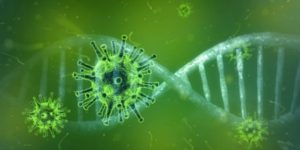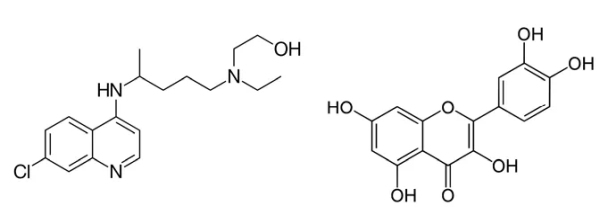 Green Star Project – Hope you are well, physically and mentally. Here are some tentative ideas about the link between coronavirus, zinc, and a natural product called quercetin, which is a flavonoid found in food.
Green Star Project – Hope you are well, physically and mentally. Here are some tentative ideas about the link between coronavirus, zinc, and a natural product called quercetin, which is a flavonoid found in food.
You’ve probably heard by now of the drug hydroxychloroquine (HCQ) that has been under investigation for treatment of Coronavirus Disease 2019 (COVID-19).
Recommendations from Chinese doctors to employ it (the initial recommendation, on Feb 18 was to employ chloroquine phosphate, a related drug) were followed by a small-scale study from French researchers, published on March 20, which was promising but not definitive.
On March 25, a Chinese study reported that HCQ did not have a significant benefit to patients, but the validity of that 30-patient study has since been questioned as it turned out that both the HCQ and control groups were also receiving other antiviral treatments. The majority of patients in that study made good recoveries so it’s hard to say whether HCQ was useful or not, and overall the jury is still out on HCQ.
Let food be thy medicine
An awful lot of the debate over HCQ and other potential treatments for COVID-19 come down to a risk versus reward analysis. When it comes to health, I usually tend to follow Hippocrates’ advice: “Let food be thy medicine,” because eating a healthy diet offers a reward at virtually no risk. How big a reward would it offer in the face of COVID-19?
Well, there has been a barrage of articles warning against coronavirus-related fads (such as drinking tonic water because it contains quinine) but most people agree that the best defenses against the virus (besides limiting its spread) are exercise, sleep, and a healthy diet.
A NY Times article on March 23 warned against an over-zealous use of supplements but concluded that it’s important to get nutrients such as zinc from a healthy diet of whole foods. Two days later, an article on CNN highlighted foods that provide good sources of immunity-boosting nutrients such as vitamin C and zinc. But to be frank, this is all fairly lightweight reporting and there hasn’t been enough focus on the importance of a healthy diet.
The importance of zinc
Since 2010, we have known that zinc inhibits replication of coronavirus in vitro – it was tested on SARS-CoV, which was responsible for the SARS outbreak in 2002. Zinc has long been recognized as an important component of our viral defenses and we should make sure to get enough of it in our diets. As the above-mentioned NY Times article pointed out, you can sometimes do damage if you overdo it on nutritional supplements – your body can only absorb so much zinc – so if you do supplement, stay within the recommended range of around 10 mg per day.
Many more people than previously thought are actually zinc-deficient; A 2017 review on zinc, summarized that nearly 30% of the elderly population is zinc-deficient and that:
“In developing countries, zinc deficiency is the 5th leading cause for the loss of healthy life years. In industrial countries, mainly the elderly population is affected by zinc deficiency.”
Personally, I’ll be relying mainly on food sources for my zinc supply, such as seeds, legumes, mushrooms and spinach. But there’s one other important factor besides getting zinc into our bodies and that’s getting it into the cells that are threatened by coronavirus.
Hydroxychloroquine is a zinc ionophore
In the 2010 study that looked at inhibition of coronavirus replication by zinc, the researchers found that zinc ionophores block replication of the virus when administered to cell cultures. Ionophores are chemicals that can help transport ions, such as zinc, across cell membranes (because metals like zinc can’t move freely in and out of cells).
Now, it turns out that in 2014 it was discovered that HCQ is a zinc ionophore, i.e., it can deliver zinc across cell membranes. On March 10, Dr. Roger Seheult, reporting for MedCram, looked at a hypothesis that the mode of action of hydroxychloroquine could be by delivering zinc to our cells. Here’s that video, which references the papers mentioned above.
Now, it must be pointed out that this is all pretty hypothetical. The facts are that zinc was shown in vitro to inhibit coronavirus replication and that HCQ is a zinc ionophore. But it’s still uncertain that HCQ will be effective against coronavirus and even if it is, the mechanism may not even be zinc-related. Medicine is complex and a drug can have many different impacts on the body. The authors of the 2014 paper that established that HCQ can act as a zinc ionophore point out that:
“Chloroquine exerts a pleiotropic effect in eukaryotic cells, including an elevation of vacuolar pH when trapped in acidic organelles, such as lysosomes.”
Raising the pH of lysosomes is one of the main hypotheses for the mechanism of action of HCQ. The action of raising the pH may be somewhat related to HCQs property as an ionophore as they both involve the movement of ions across membranes.
In the next video, following up on the theory that the mechanism of HCQ could be zinc-related, Dr. Seheult raises the question: Are there other zinc ionophores that could work?
And that’s where quercetin comes in.

Quercetin – a naturally occurring zinc ionophore.
Quercetin is a flavonoid (a type of polyphenol) that’s present in a variety of edible plants – from herbs like cilantro and dill, to veggies and fruit such as onion, kale and cranberries, with the highest concentration found in capers. Quercetin was demonstrated to be a zinc ionophore in 2014.
“Dietary plant polyphenols such as the flavonoids quercetin (QCT) and epigallocatechin-gallate act as antioxidants and as signaling molecules. Remarkably, the activities of numerous enzymes that are targeted by polyphenols are dependent on zinc. We have previously shown that these polyphenols chelate zinc cations and hypothesized that these flavonoids might be also acting as zinc ionophores, transporting zinc cations through the plasma membrane.”
If HCQ proves to be effective in treating COVID-19 then it’s possible that quercetin in our diet may also be protective (while avoiding the side effects of HCQ). But that’s also predicated on quercetin having a similar effect to HCQ in patients and again, medicine is complex.
Quercetin – other chances that it may be helpful in treating COVID-19
Quercetin and plants that contain it have a certain following for treatment of various conditions – for example, capers are used in Iranian Traditional Medicine. Taking a look at the scientific studies carried out specifically on quercetin, here are some highlights:
- In 2015 it was reported that quercetin inhibits entry of the influenza A and the H5N1 virus to cells in vitro.
- Quercetin was also found to inhibit adhesion of the human respiratory syncytial virus (hRSV).
- Researchers from Oak Ridge National Lab used the world’s most powerful supercomputer, SUMMIT, to look for small molecules that might inhibit the COVID-19 spike protein from interacting with human cells and interestingly, quercetin is fifth on that list.
- This is not a peer-reviewed scientific publication but Leo Galland also recommends quercetin, but via a different mechanism (mTOR modulation). Incidentally, his other recommendations can also be obtained from food sources: curcumin (turmeric), rosmarinic acid (rosemary, sage, oregano), resveratrol (red wine and grapes), and elderberry.
So it boils down to two possible benefits from quercetin: modulation of zinc transport into cells (and possibly altering the pH in lysosomes) and blocking viral docking to host cells.
Bottom line: should you eat quercetin-rich foods?
I feel comfortable with the idea of eating zinc-rich foods that also qualify as healthy foods (e.g., seeds, legumes, mushrooms, and spinach). I’m somewhat comfortable with doing the same for foods that are moderately rich in quercetin (e.g., kale, onions, peppers, and elderberry juice).
The one thing that gives me pause is that consumption of the most quercetin-rich food, capers, is high in the countries where COVID-19 has a strong mortality rate: Italy, Spain, France and Iran. I know – there are myriad reasons why these countries are more strongly impacted. I also know that some of the above is merely armchair science. But I figure that it’s useful to share thoughts in case they spark an idea or study that can take us a little closer to a treatment.
SF Source Green Star Project Oct 2020

Quercetin is a pretty safe support for prevention and treatment of virus/flu/cold.